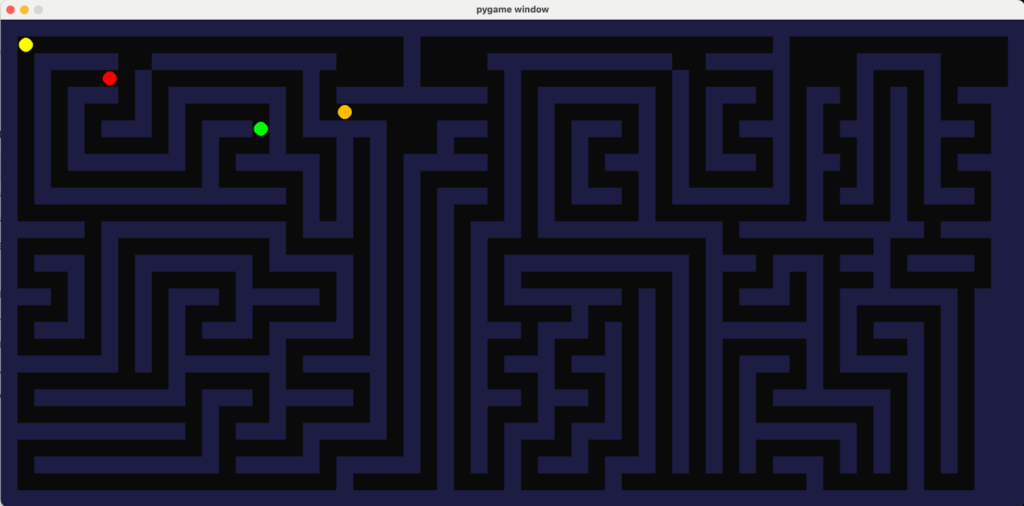Imagine you’re coding a small robot to escape a maze. Either you make it explore every path until it finds the exit, or give it hints to guess which are the best ones. That little guessing power is what we call a heuristic, and it’s one of AI’s oldest tricks for making computers feel smart. A little spoiler: AI as we know it, it’s just a bunch of tricks.
In this article, we’ll explore how these “tricks” evolved into the foundations of modern artificial intelligence. You’ll learn:
- How classic pathfinding algorithms like Breadth-First Search (BFS),
- Uniform-Cost Search (UCS) laid the groundwork for smarter approaches and
- How A* combined structure with intuition to make machines “think” more efficiently.
So without further ado, let’s get into it.
From Dumb Search to Smart Search
Early AI pioneers like Newell and Simon built programs like the Logic Theorist and General Problem Solver (GPS) that could solve puzzles. The problem was, they were slow. They took a lot of time exploring states, like a toddler flipping every light switch in the house just to find one that works. Early AI systems used methods like Breadth-First Search (BFS) or Uniform-Cost Search (UCS) to guarantee an optimal path. But they often wasted time exploring irrelevant routes.
Then came A*, the rock star of search algorithms. It combines the structure of UCS with the intuition of heuristics. Instead of blindly checking every option, A* estimates how close each path is to the goal with a heuristic function like “distance to target.”
Mathematically, A* ranks nodes by:
f(n)=g(n)+h(n)
Where
- g(n)= cost so far (real distance traveled)
- h(n)= heuristic estimate of remaining distance
If h never overestimates, A* still guarantees the best path, but often 10× faster than UCS.
Why Heuristics “Hits Different”
Heuristics encode intuition. They give algorithms that human-like intuition. They’re not brute force, they’re shortcuts based on experience.
Picture this: You’re wandering around a new city looking for a café. You probably won’t pull out a map of every possible street corner and compute every route. You will most likely guess to head downtown because cafés usually cluster there. That’s exactly how A* thinks: instead of exhaustively searching the entire map, it estimates which paths are probably leading closer to the goal, and focuses there first.
That’s why heuristics feel almost human. They compress experience into shortcuts: little rules that work well most of the time without needing the full picture. In video games like Pac-Man heuristics make enemies look smart. Those ghosts chasing you are not omniscient or almighty beings with self-consciousness. They’re using simple distance heuristics to decide whether to go up, down, left, or right. In robotics, heuristics help drones avoid obstacles by estimating proximity rather than scanning every inch. In Google Maps, they help you find the best route in milliseconds.
But here’s the twist: choosing a good heuristic is an art form and that’s because:
- If the heuristic is too conservative — say, always assuming the goal is farther away than it really is, A* slows down and basically reverts to Uniform-Cost Search (UCS), exploring almost every option before reaching the answer. It’s correct, but painfully inefficient.
- If the heuristic is too aggressive — and it’s wildly overestimating the remaining cost, it starts behaving like a Greedy Best-First Search, chasing what looks good locally but possibly missing the optimal path entirely.
Balancing speed and certainty is what defines intelligent design in AI. A perfect heuristic is informed enough to guide the algorithm quickly, but also humble to not mislead it. That tension, between intuition and logic, efficiency and accuracy, is what makes modern AI so fascinating. Whether it’s a self-driving car deciding when to turn, a delivery drone rerouting mid-flight, or a digital ghost plotting the fastest way to catch you, it all comes down to the same question: how much can we trust our intuition to be right and fast enough?
From Mazes to Minds: Heuristics Beyond Mazes
Turns out, that question doesn’t just live inside a maze. It echoes across every field that tries to make decisions under pressure, from board games to machine intelligence.
As said, heuristics are the quiet superpower behind almost everything that feels intelligent. Once AI researchers realized that intuition could be expressed mathematically, it stopped being a shortcut and became a principle: the science of smart guessing.
In chess, engines like Stockfish or AlphaZero don’t calculate every move—they use heuristics to prune bad options. In reinforcement learning, agents use heuristics to estimate which actions will pay off. In everyday life, we rely on heuristics to make quick choices under uncertainty.
Psychologists like Herbert Simon and Daniel Kahneman call this bounded rationality. The idea that intelligence isn’t about infinite accuracy, but about making good enough decisions in limited time. That’s what heuristics really are: not hacks, but expressions of efficiency.
So, when AI formalized heuristics, it didn’t just make machines faster, it made them more human. Every self-driving car that predicts merging traffic, every recommender system that guesses what you’ll like next, every search engine that ranks relevance, they’re all doing what A* does in a maze: trusting a well-informed hunch.
That’s the core of modern AI: Intuition turned into computation, speed balanced with accuracy, logic made practical. And to really see that balance come alive, we can turn to a tiny world we all know: one yellow circle, four ghosts, and a maze full of choices.
A Tiny Demo: Comparing Search Strategies with Pac-Man
Let’s put all this theory to the test:

In our Pac-Man simulation, you take control of Pac-Man while three ghosts chase you, each guided by a different kind of thinking:
- One ghost uses Depth-First Search (DFS): Charging headlong down corridors until it has to backtrack.
- Another uses Breadth-First Search (BFS): Sweeping methodically through every path in perfect order, patient but predictable.
- And then third one uses A*: Powered by heuristics that let it cut corners, anticipate your movements, and hunt you down with unsettling precision.
Each ghost embodies a different philosophy of intelligence:
- DFS acts on impulse — fast, erratic, often lost.
- BFS is organized — deliberate, but painfully slow.
- A* feels alive — strategic, adaptive, almost intuitive.
As you play, you’ll notice the difference: DFS gets lost, BFS takes its time, and A* seems to anticipate your every move. That’s not just code, it’s a microcosm of how real AI balances brute force with foresight, certainty with speed. That’s how heuristics guide decision-making.
Conclusion: From Intuition to Intelligence
In the end, it all comes back to one maze, three ghosts, and a simple truth: the smartest moves in artificial intelligence don’t rely on brute force, but on guided intuition. AI heuristics transformed search from mechanical trial-and-error into something closer to strategy, a way for pathfinding algorithms to sense direction, filter out noise, and focus on what truly matters.
What began as a simple heuristic function evolved into a philosophy: intelligence is the art of not wasting effort. Every quick GPS reroute, every optimized chess move, every drone adjusting to the wind, they all reflect the same idea visible in Pac-Man’s maze: thinking fast without thinking shallow.
Ultimately, the power of AI isn’t just in how it finds solutions, but in how it finds them efficiently, intelligently, and with purpose.
Explore our
AI in Recruiting Automation: Guide for Tech Hiring with Autonomous Agents + Top AI Recruiting Tools
HR decision-makers in tech are facing a seismic shift in how hiring gets done. AI in recruiting automation – the use of AI-driven tools and autonomous agents to streamline hiring – is moving from buzzword to baseline. In fact, 37% of firms are integrating generative AI into their HR processes (up to 27% a year…
How AI-Driven RevOps Automation Transforms Revenue Operations for Tech Companies
Revenue Operations (RevOps) is no longer just a buzzword—it’s becoming the backbone of modern SaaS and tech growth. By breaking down silos between sales, marketing, and customer success, RevOps creates one engine that drives predictable and scalable revenue. And here’s the kicker: by 2026, 75% of the fastest-growing companies will run on RevOps. That’s huge.…
How Much Should You Invest in Data Security to Stay Ahead in 2026
Data security has moved from being a technical safeguard to a core business strategy. With cyberattacks increasing in both scale and sophistication, technology leaders are under pressure to not only defend infrastructure but also protect customer trust and ensure regulatory compliance. A recent IBM report highlights the scale of the challenge: 68% of organizations experienced…






